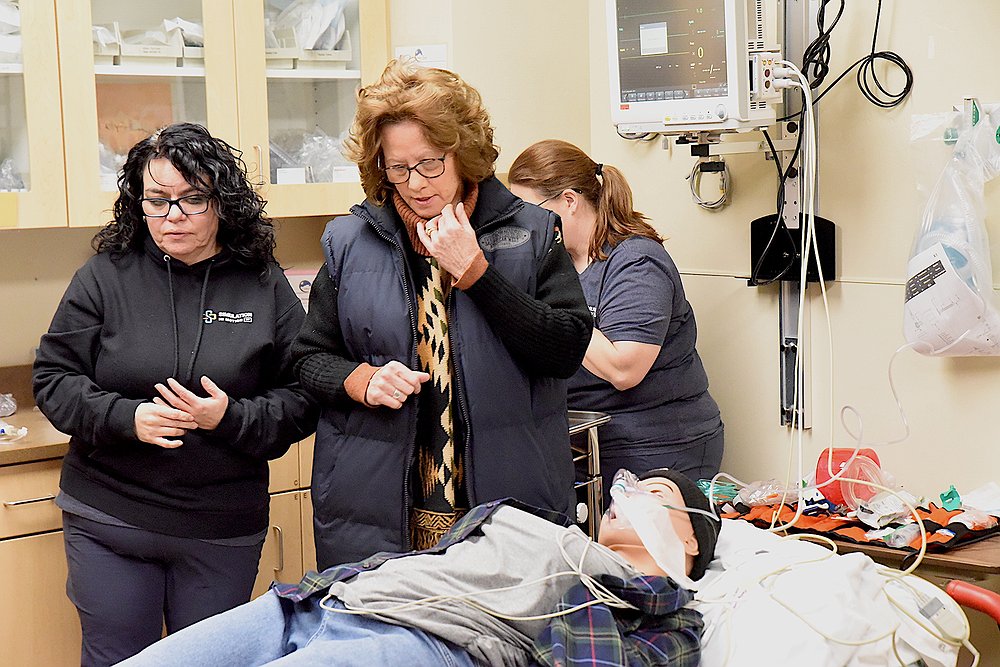Local health care providers get training in sepsis
Sepsis is a significant killer annually in the U.S., but work is being done to help area emergency medical services and nurses decrease deaths.
Wednesday, Cabinet Peaks Medical Center hosted a special training event for its staff and volunteer ambulance service members.
According to the Centers for Disease Control and Prevention (CDC), sepsis is one of the leading causes of death in hospitals. In the United States, an estimated 1.7 million adults develop sepsis annually with about 350,000 of them dying from the condition. It’s the third leading cause of hospital deaths nationally.
Staff from Helena-based Simulation in Motion Montana (SIM-MT), which works with the Montana Health Research and Education Foundation (MHREF), held a simulation training session for EMS personnel from volunteer ambulance services in Libby and Troy as well as nurses at Cabinet Peaks.
According to Simulation in Motion Program Director Lee Roberts, high-fidelity simulation uses advanced, lifelike manikins to replicate real medical emergencies, enabling healthcare teams to practice and refine their skills in a realistic, controlled environment. This type of immersive training ensures that healthcare professionals are prepared to deliver life-saving care in high-stakes situations like sepsis management.
“We are excited to partner with Cabinet Peaks Medical Center and MHREF to provide this high-quality educational experience,” Roberts said. “Sepsis is one of the most time-sensitive and complex conditions to treat, and this training equips healthcare teams in Libby and Troy with the skills and confidence needed to save lives in their community.”
According to the CDC, when germs get into a person's body, they can cause an infection. If the infection isn’t quickly treated, it can cause sepsis. Bacterial infections cause most cases of sepsis. Sepsis can also be a result of other infections, including viral infections, such as COVID-19 or influenza, or fungal infections.
Wednesday’s training included four groups of EMS personnel and nurses whom went through the training scenario and then had the chance to learn what they did well and what they needed to improve during a debriefing session.
Troy Volunteer Ambulance’s Bobbie Scott and Janet Miller were the first EMS team to train.
Simulation in Motion’s Priscilla Harris and Amber Olson explained the features and use of its female manikin named “Lucy.”
In the simulation, Harris played the daughter of Lucy, a 48-year-old woman who had recently lost her husband to lung cancer. Harris called 911 after finding her mother, “Lucy,” moaning and groaning in her home. The cattle on the ranch hadn’t been fed and Harris knew her mother was in trouble.
Her house was home to 20 cats and in a filthy condition, including the strong odor of cat urine.
“We’d been fighting because she was still smoking two packs a day and I wanted her to quit,” Harris said.
Scott and Miller agreed the scenario was similar to real life calls they’ve had locally in south Lincoln County.
“A lot of people here still smoke quite a bit,” Miller said.
EMS personnel and hospital nurses were able to record the manikin’s temperature, blood pressure and other vital signs while giving her an IV.
An X-ray also showed a lung infection, possibly pneumonia, as well as a wound on a big toe that may have become infected.
Harris explained some of SIM-MT’s motivation.
“We pride ourselves on training at high acuity and low volume facilities in Montana, Wyoming and Idaho where it’s difficult for staff to get away because of their locations,” she said. “And that certainly is prevalent in this region.
“Mistakes are part of the job, but making them in these training sessions are certainly preferable to a real-life situation.”
The event also highlighted SIM-MT’s collaboration with MHREF, a not-for-profit organization established in 1973 by the Montana Hospital Association. MHREF’s structure enables partnerships that bring vital training opportunities like this to rural healthcare facilities, ensuring that communities across Montana have access to exceptional care.
Since SIM-MT began it mobile team in 2018, it has provided training for more than 7,100 providers in 11 medical professions. The training has occurred in 101 different Montana communities in 50 of 56 counties.



